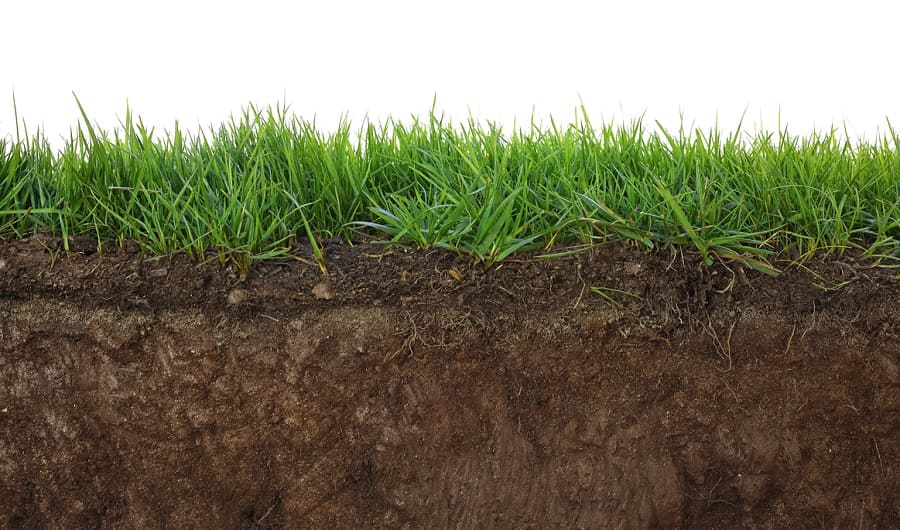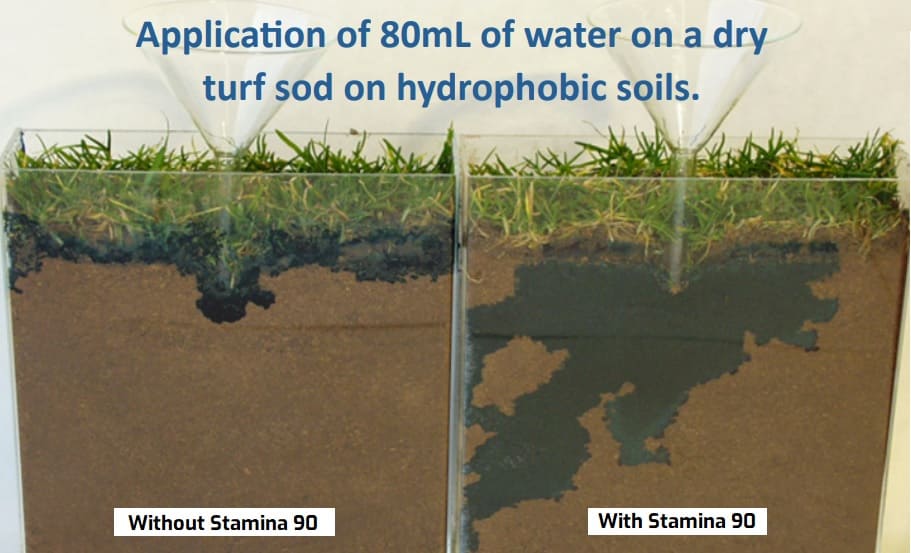How Soil Wetting Agents Work and Why You Should Use Them
Water is one of the most important resources required by plants for growth and development. Water must be readily available in the soil for use in photosynthesis, to solubilise soil nutrients, cool itself through transpiration and maintain internal moisture and structural rigidity. When the level of water available in the soil begins to drop, the plant may reach a point where it is utilising water faster than it is accessing it. This is known as the wilting point and is one of the first signs of plant dehydration.
In addition to the water required for the turfgrass plant, a certain level of soil moisture is required to maintain an appropriate playing surface for many sports. For example, if left to dry out to 0% soil moisture, a football field would have the potential to cause injury to players, a golf green would roll too quickly and a cricket pitch would bounce too hard. As the presentation of playing surfaces is the key objective in sportsturf management, soil and surface moisture are often of primary concern.

How do soil wetting agents work?
In Australia, the unpredictability and extreme nature of our climate often requires the use of soil wetting agents in order to present turfgrass surfaces of an acceptable standard. There are many different varieties of soil wetting agents in the Australian turf industry and many serve different purposes. However they all rely on their active constituents’ ability to affect the surface tension and physical behaviour of water. This changes the way the water molecules interact with each other and their physical surroundings. The differences in the mode of action of the different available formulations results in variations in the way the products work, and therefore variations in their application. While some wetting agents specialise in overcoming hydrophobic conditions and re-wetting soil, others may be specialist penetrants, or may be highly residual.
Wetting agents work by modifying the surface tension of water on a molecular level, hence the name surfactants which means surface acting agents. The polarity (charge) of water results in adhesive forces making molecules cling to surrounding surfaces, as well as cohesive forces that make them cling to other water molecules. When a surface is hydrophobic it means it repels water, and when it is hydrophilic it is attracted to (or has an affinity for) water. In a soil situation hydrophobicity will frequently occur when the breakdown of organic matter results in the production of natural acids that can coat soil particles in a waxy residue. The waxy coating repels surrounding water, and thus the soil particles become hydrophobic.

When straight water is applied to a hydrophobic area the water will pool on the surface, reluctant to enter the profile. Over time it may begin to infiltrate the soil; however it will often not actually wet the soil, instead it will drain through leaving the profile dry. This occurs as the water moves past the hydrophobic soil particles, without attaching to or adsorbing to any particles is passes, instead it simply finds its way through and out the bottom. The addition of wetting agent to this situation will reduce the surface tension of the water to promote infiltration, and will then allow the water to interact with the hydrophobic particles as it percolates through the profile.
The reduction in surface tension occurs when the wetting agent molecule pushes its way between two water molecules, forcing them apart and reducing their cohesive bond. This essentially “thins” the water out, allowing the molecules to act more independently of each other, spreading over a greater surface rather than clumping up together cohesively. The water can now move more freely, entering the soil under the force of gravity. Now that the surface tension has been reduced and the water has entered the profile, the wetting agent molecule acts as a link between the water and the soil particle. This occurs due to the nature of the surfactant molecule, possessing a lipophilic (wax loving) end that sticks to the water repellent surfaces and a hydrophilic end that sticks to the water molecule, acting as a bridge. Without the addition of a specialised wetting agent, hydrophobic soil will have to be wet regularly over a long period in order to become rehydrated. By the time rehydration occurs the plant will most likely be past wilting point and potentially beyond recovery.
Water in sand-based profiles
The longevity, availability and quantity of water in the soil are highly dependent on factors such as soil type and environmental conditions. The texture of the soil is one of the most influential soil characteristics with regard to water infiltration and retention. In finer textured or heavier soils there is a much larger surface area for water to cling to, and consequently, these soils will generally hold on to more water for a longer period. The coarser textured soils have a reduced surface area for water to cling to, and so generally hold less water for a shorter period of time. Organic matter also plays an integral role in the retention of water in a soil profile, acting as a sponge in the otherwise non-absorbent environment. In a sand-based profile, organic matter is vital in providing turf roots with a reservoir of available water.
As coarse sand-based materials are generally desirable in many sportsturf construction methods such as USGA specifications, it is essential that these issues be managed. Stamina Balance is a complex and innovative formulation of surfactant molecules, designed to serve specific purposes. The formulation includes a long-chained polymer for improved uniformity of lateral wetting throughout the profile, a strong surface acting agent to ensure initial penetration and a heavy surfactant molecule for optimised residual performance. Together these three modes of action work to turn a sand-based profile into a soil that can properly receive and retain water for use by the turfgrass plant.
Stamina Balance trial in coarse sand-based materials:
The roles of different surfactants in soil wetting agents:
- Long chained polymer: Significantly improves water retention in sand-based root zones. These polymers enhance depth and uniformity of wetting
- High-surface tension acting surfactant: Ensures initial water penetration and maximises water availability to the plant
- Residual surfactant: Provides residual activity, rewetting performance and overcomes soil hydrophobicity.
Managing Localised Dry Spot
Localised Dry Spot (LDS) is a non-infectious condition suffered by turfgrass in droughty conditions. Hydrophobic soils develop in localised patches resulting in non-uniform wetting of soil that becomes visible on the turf surface as patches of foliage begin to wilt and discolour. To prevent LDS from occurring, regular applications of a residual wetting agent are most effective.
This will prevent hydrophobic conditions from developing when rainfall is low or irrigation is infrequent. Stamina 90 is a concentrated specialty wetting agent designed specifically for long-term prevention of LDS and general hydrophobicity. The molecule in Stamina 90 is larger than that in most other wetting agents, thus resisting degradation and lasting longer in the soil. Not only do regular applications of Stamina 90 guard against the occurrence of LDS, but also help to build a healthy soil environment by retaining moisture evenly throughout the profile.

Curative treatment of LDS is best achieved through applications of a specialty wetting agent such as Stamina Rescue. The formulation of Stamina Rescue is highly unique in that it contains a high surface acting agent to overcome hydrophobicity, as well as a heavier molecule for residual performance. In addition to the two surfactant molecules, the formulation also contains a blend of amino acids, humates and saponins to aid in plant recovery. This significantly improves surface recovery and regeneration following LDS damage, particularly when used in conjunction with biostimulants to rebuild root health.
Nuturf’s Stamina Range features a specialised wetting agent for every requirement. The Stamina Range is manufactured in Australia for Australian conditions. Speak to your Nuturf Territory Manager about a specialist wetting agent that suits your needs.













